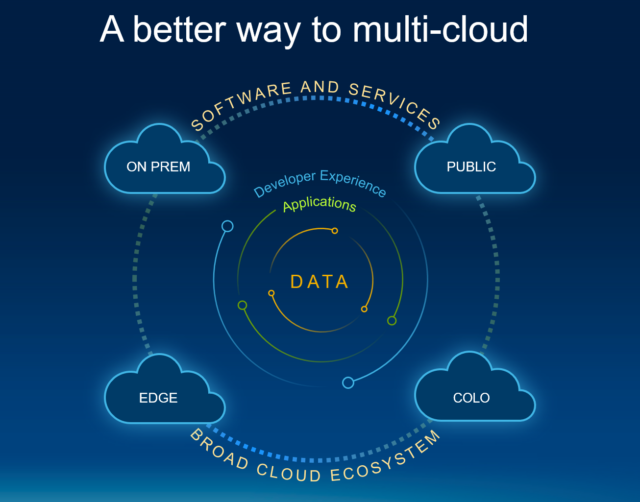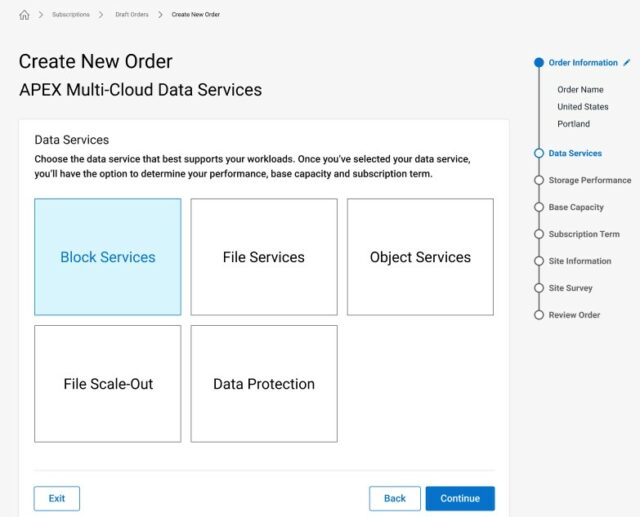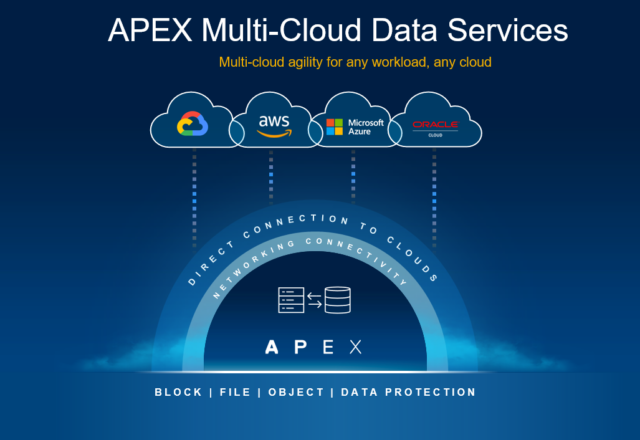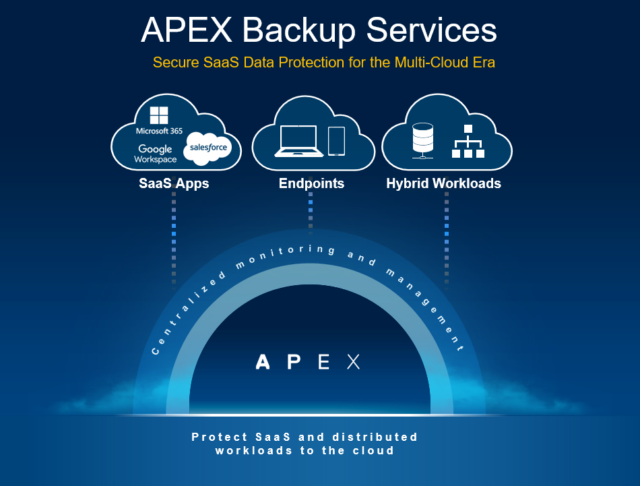I enjoy debates about technology trends as much as the next person, but there’s one trend that’s not up for debate anymore – multi-cloud is the standard for most organizations. 78% of cloud users leverage multiple public clouds.¹ The trend is really driven by data growth and the need to accelerate digital transformation. As data is the lifeblood of digital organizations, this means that applications (and infrastructure) are running in more and more locations – in multiple public clouds, customer datacenters, co-lo facilities and increasingly, at the edge. Organizations want a consistent cloud experience – quick provisioning, ability to scale easily and access to developer services – for their technology resources in all these locations. That is the ultimate promise of the multi-cloud world.
However, most organizations aren’t realizing that promise yet, as they find themselves in a multi-cloud by default world. They have applications and data residing in multiple cloud environments, but there is not much consistency between these environments, resulting in unpredictable costs, skill gaps within IT teams, issues with data security and governance, as well as challenges to developer productivity.
At Dell, we believe there is a better way. We are helping build a multi-cloud by design world, in which organizations can:
- Easily access their data, wherever it is created and stored, in a safe and secure manner.
- Consume cloud services anywhere their business needs it.
- Increase developer productivity.
- Improve spend predictability and transparency.
- Maintain operational consistency across cloud environments, allowing them to leverage existing skills sets.
 We will make this multi-cloud by design world a reality by delivering cloud software and services that can span our customers’ distributed technology footprint, as well as by helping build a cloud ecosystem that works together. Today marks an important day in this journey, as we unveil new capabilities that help simplify multi-cloud storage and data protection, as well as boost developer productivity in multi-cloud environments. Let’s look at the key announcements from today’s launch.
We will make this multi-cloud by design world a reality by delivering cloud software and services that can span our customers’ distributed technology footprint, as well as by helping build a cloud ecosystem that works together. Today marks an important day in this journey, as we unveil new capabilities that help simplify multi-cloud storage and data protection, as well as boost developer productivity in multi-cloud environments. Let’s look at the key announcements from today’s launch.
New APEX multi-cloud services
Dell Technologies APEX plays a critical role in enabling this multi-cloud by design world. APEX is all about delivering a cloud experience to our customers wherever they want it. As part of this launch, we are adding new multi-cloud services to the APEX portfolio.
APEX Multi-Cloud Data Services provides block, file, object and data protection storage services with direct access to all major public cloud providers (AWS, Azure, Google and Oracle Cloud) simultaneously through high-speed, low latency connections. Organizations can leverage the public cloud compute and application services of their choice and easily switch between clouds without having to move their data. This avoids cloud vendor lock-in and excessive egress fees. With this service, organizations get the benefits of enterprise-class storage, coupled with the benefits of public cloud. Storage and public cloud compute can be scaled independently so organizations only use the compute they need. Organizations’ on-prem storage can also be extended to this service using familiar tools with native array replication.

Using the APEX Console, users can easily add or remove new cloud connections, increase or decrease bandwidth to scale connectivity as needs change, enabling true multi-cloud agility delivered as-a-service for any workload and any cloud.
“APEX Multi-Cloud Data Services lets our customers implement their big data (e-discovery) applications with the scalability of the cloud, the performance of on-premises infrastructure, at a very attractive cost.” – Jordan McQuown, CTO of GeorgeJon.

APEX Backup Services is another addition to the APEX Cloud Services portfolio, providing in-cloud backup for organizations’ most critical workloads. It is a SaaS-based solution that provides end-to-end protection for SaaS applications (such as Microsoft 365 and Salesforce), endpoints and hybrid workloads. Because this service is 100% SaaS-based, users will never have to worry about the downtime required to perform updates. Updates are released automatically without impact to production environments, ensuring the latest version is always running. And with quick and easy onboarding, admins can set up a backup policy within minutes.
The threat of cyberattacks is top of mind for our customers, which is why APEX Backup Services is introducing features that will provide a multi-layer defense system. This includes intelligent alerts to warn of malicious activity, the ability to isolate or delete corrupted data, and curated backups to ensure a safe and full recovery.
“Data Protection is a top priority for the State of Illinois. In addition to cybersecurity, disaster recovery and backup for our hybrid workloads, we required a solution that was easy to manage. APEX Backup Services hit the mark in terms of simplified management at scale with a single interface and fast deployment.” – Joseph Daniels, CIO, Illinois State Treasurer’s Office.

We have also enhanced the APEX portfolio with key updates to APEX Data Storage Services and are pleased to announce the availability of APEX Cloud Services with VMware Cloud.
Project Alpine
In addition to the innovations being delivered today, we are building on our commitment to a better multi-cloud data experience with Project Alpine. Organizations rely on Dell’s extensive storage portfolio that addresses a diverse set of needs across the entire data lifecycle, thanks to performance at scale, built-in autonomous operations capabilities, as well as the robust security and data protection we provide. With Project Alpine, we will bring the unique capabilities of our block and file storage platforms to the public cloud, delivered as cloud software and cloud services. Project Alpine will deliver the best of both worlds – the enterprise grade data services in our storage software , combined with the benefits of public cloud. It will bring operational consistency in hybrid cloud environments – allowing organizations to seamlessly manage data between on-prem and public cloud environments with consistent M&O tools and existing skills. Plus, they will have the flexibility to pay using cloud credits.
Delivering cloud software is not new to Dell. We are protecting nearly nine exabytes of data in the public cloud across 1400 customers² with our PowerProtect software (available in all major cloud marketplaces today). We are continuing to invest in this space, most recently making our Cyber Recovery software available in AWS to use the cloud as an air-gapped cyber vault.
 When it comes to the prevalence of multi-cloud, data is at the center of everything. Where there is data, there are applications. With data and apps being more and more distributed across locations such as on-prem, public cloud, colocation facilities and at the edge, what customers need is a simple and secure operating model to support deployment and management of these apps anywhere. To help IT teams deliver applications faster and accelerate developer productivity, we’ve also extended our DevOps ready platforms and introduced our refreshed Developer Portal.
When it comes to the prevalence of multi-cloud, data is at the center of everything. Where there is data, there are applications. With data and apps being more and more distributed across locations such as on-prem, public cloud, colocation facilities and at the edge, what customers need is a simple and secure operating model to support deployment and management of these apps anywhere. To help IT teams deliver applications faster and accelerate developer productivity, we’ve also extended our DevOps ready platforms and introduced our refreshed Developer Portal.
To learn more about these announcements and how Dell can help you realize true multi-cloud by design, visit our cloud page.
¹ HashiCorp State of Cloud Strategy Survey
² Based on internal Dell Technologies research, October 2021
